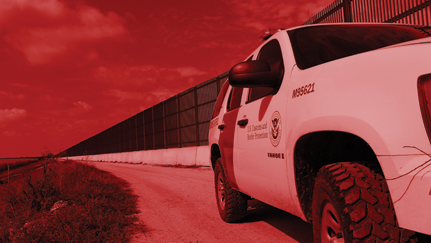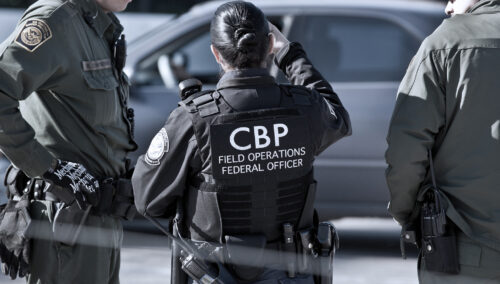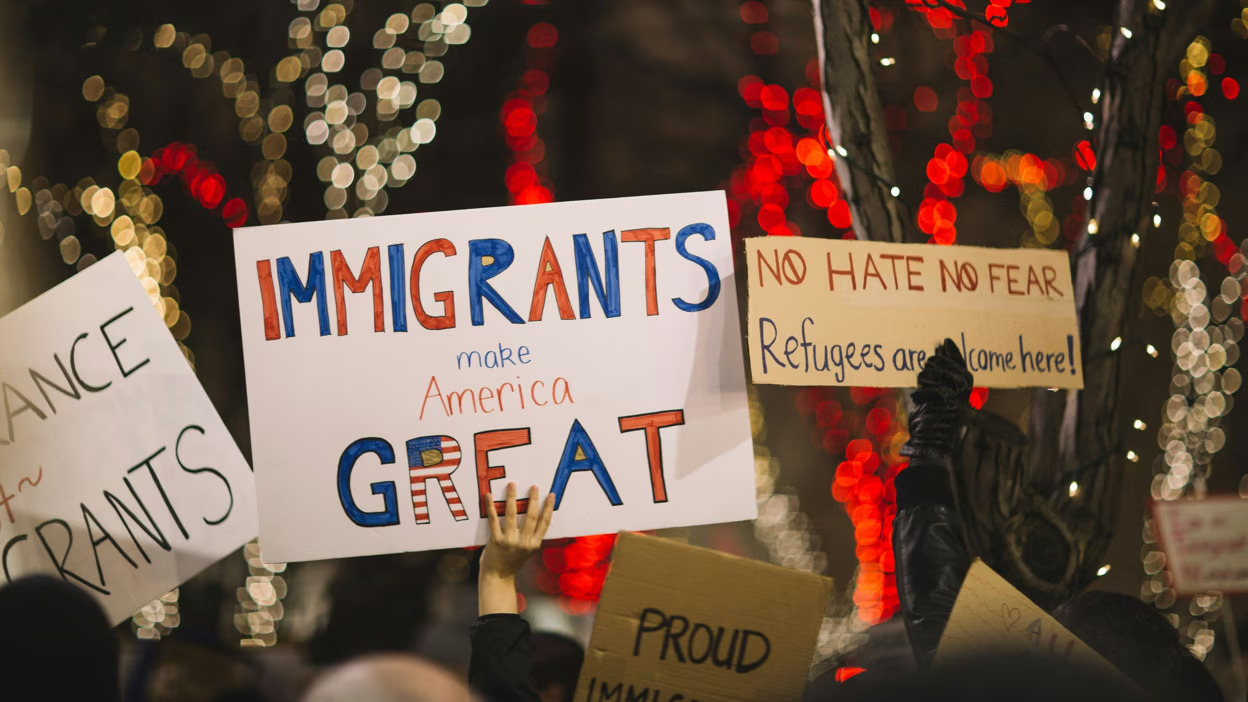U.S. Customs and Border Protection (CBP) has a long history of violating constitutional and other rights of both immigrants and U.S. citizens. More precisely, agents of the Border Patrol (a component agency of CBP) are known for regularly overstepping the boundaries of their authority by using excessive force, detaining people under inhumane conditions, and using coercion and misinformation to remove people from the United States. Not only do alleged abuses occur with regularity, but they rarely result in any serious disciplinary action. This was illustrated in a previous report from the American Immigration Council titled No Action Taken: Lack of CBP Accountability in Responding to Complaints of Abuse, which analyzed data from January 2009 to January 2012.
According to more recent CBP data obtained by the American Immigration Council, the agency has made little progress in its efforts to improve accountability. This data, obtained through a Freedom of Information Act (FOIA) request, includes 2,178 cases of alleged misconduct by Border Patrol agents and supervisors that were filed between January 2012 and October 2015. These cases range from instances of verbal abuse, to theft of property, to physical assault.
Even though assessing which cases did or did not merit disciplinary action was not feasible with the information CBP provided, the overall findings of this report are still remarkable. For example:
- 95.9 percent of the 1,255 cases in which an outcome was reported resulted in “no action” against the officer or agent accused of misconduct.
- The complaints contain allegations of many forms of abuse, with “physical abuse” cited as the reason for the complaint in 59.4 percent of all cases.
- “No action” was the outcome of many complaints against Border Patrol agents that alleged serious misconduct, such as running a person over with a vehicle, making physical threats, sexually assaulting a woman in a hospital, and denying medical attention to children.
The number of complaints filed varied widely by location. The most complaints were filed against agents in the Rio Grande Valley Sector (Texas), Tucson Sector (Arizona), and Laredo Sector (Texas). Collectively, these three sectors accounted for more than 80 percent of all complaints filed.
When accounting for the number of apprehensions per sector, however, a different pattern emerges. By this measure, the highest complaint rates were in the Yuma Sector (Arizona), with 218.7 complaints per 100,000 apprehensions; the Big Bend Sector (Texas), with 192.5 complaints; and the El Paso Sector (Texas), with 185.4. Alternately, when complaints are measured against the number of Border Patrol agents per sector, the highest complaint rates were in the Rio Grande Valley Sector (315.2 complaints per 1,000 agents), Laredo Sector (130), and Tucson Sector (112.8).
Overall, the data analyzed in this report raises concerns about misconduct throughout Border Patrol sectors, and what CBP has done to address these problems and improve accountability.
In any democratic society, government agencies must be held accountable for their policies and the actions of their personnel—meaning that the operations of an agency must be subject to review and oversight by the public and elected officials to the greatest extent possible. For law enforcement agencies, including CBP, the political process is an important accountability mechanism. If political leaders are dissatisfied with some aspect of the agency’s performance, they can take steps to reform the agency or replace its leadership. Another key aspect of accountability, however, involves taking appropriate action when misconduct complaints are lodged against agency personnel.
Within CBP, the Border Patrol particularly suffers from poor accountability. This is apparent from recommendations in a 2013 report from the Police Executive Research Forum (PERF) which addressed, among other things, the tendency of Border Patrol agents to use deadly force against individuals throwing rocks at them or driving motor vehicles—even when the agents were not in mortal danger. Moreover, these kinds of incidents were reported in an inconsistent and haphazard fashion even within CBP, making it difficult for anyone to determine the extent to which abusive practices were taking place. In other words, Border Patrol abuses have persisted for so long, in part, because relatively little accurate information has been collected about them.
Yet incidents of misconduct involving Border Patrol agents are, unfortunately, far from isolated. There is no denying that such abuses have long indicated systemic problems within the agency. For instance, a 2006 study based on data collected between 1999 and 2002 found that Salvadoran deportees were 1.5 times (or 150 percent) more likely to experience physical force during arrest than were native-born citizens. In addition, there is ample anecdotal evidence suggesting that beatings by Border Patrol agents are commonplace. At its most extreme, this violence has degenerated into outright murder.
While excessive physical force is the most severe form of misconduct, it is not the only one. The allegations reviewed in this report range from beatings, sexual assaults, and denial of medical care, to theft of detainees’ personal property, including money and identification documents. Not only do Border Patrol agents commit such abuses with regularity; they are seldom disciplined for doing so. A report from the American Immigration Council based on data from 2009 to 2012 was the first systematic effort to document how CBP handled complaints of misconduct lodged against its personnel. The report found that, among those cases in which a formal decision was issued, 97 percent resulted in “no action taken.” Moreover, among all complaints filed over that three-year period, 40 percent were still “pending investigation” when the complaint data were provided to the Council.
In response to reports such as those discussed above, reforms designed to increase CBP’s accountability and transparency were introduced at the agency. In September 2014, for example, then-Homeland Security Secretary Jeh Johnson announced that CBP would thereafter have criminal authority to investigate complaints within the agency. Prior to the change, the CBP Office of Internal Affairs (OIA)—now the Office of Professional Responsibility, led by Assistant Commissioner Matthew Klein since 2015—was in charge of reviewing complaints of personnel misconduct. According to then-CBP Commissioner Gil Kerlikowske, OIA had insufficient authority to investigate or act upon claims of abuse within the organization. Under the new policy, qualified OIA employees could serve as criminal rather than general investigators. In addition, CBP adopted a unified review process for use-of-force incidents in order to resolve those incidents in a timely fashion. CBP also adopted a new “Integrity and Personnel Accountability Strategy” for all employees to foster a culture of integrity and eradicate corruption within the agency.
It is important to keep in mind that, for every complaint of misconduct filed against a CBP official, there are probably many others which have not been reported simply because the process of filing a complaint is so difficult and confusing, particularly for someone who has just been deported. For instance, complaints could only be filed in English until 2015. On April 29 of that year, CBP made a Spanish-language complaint form available, yet the agency did not announce its capacity to process complaints in Spanish until eight months later, on December 28, 2015. While this was a welcome development considering that most deportees are from Spanish-speaking countries like Mexico or Central American nations, the needs of individuals who speak neither English nor Spanish remain unaddressed.
Beyond the issue of language accessibility is the sheer complexity of the complaint-filing process. Complaints of criminal or non-criminal misconduct by CBP employees (or contractors) can be submitted directly to the DHS Office of Inspector General (OIG), to the Joint Intake Center (JIC), to CBP’s OIA, or to DHS’s Office for Civil Rights and Civil Liberties (CRCL). The OIG is given a right of first refusal for all complaints, screening not only the complaints it receives directly but also those submitted through other channels. If the OIG declines to investigate a complaint, it will either be returned to the originating office or, with respect to complaints submitted directly to OIG, sent to CRCL and/or to the JIC for referral to OIA. According to a CBP-commissioned report released in 2015 by Pivotal Practices Consulting, obtaining accurate information about the status of any given complaint is one of the difficulties resulting, predictably, from this confusing process.
While most of the recommendations contained in the Pivotal Practices report have yet to be implemented, CBP seems to have taken one suggestion to heart: to do away with the “no action” label when describing “unsubstantiated cases” and, instead, use a term indicating that there was “insufficient evidence” in such cases. CBP appears to have adopted this recommendation, based on a January 2017 report issued by the agency on misconduct allegations against CBP personnel. For that report, the label “Discipline Not Warranted” described those cases in which the agency did not take action in response to a particular allegation, rather than “No Action.” The agency reached a decision of “Discipline Not Warranted” in 4,610 cases, or 58.2 percent, of the total 7,920 cases closed in Fiscal Year (FY) 2015 that alleged misconduct by CBP personnel. In explaining why nearly three-fifths of cases closed in FY 2015 required no disciplinary action, CBP stated that many “allegations of misconduct” were “unsubstantiated or unfounded.” After “Discipline Not Warranted,” the next most common outcome was “Counseling” (17.9 percent of cases), followed by “Written Reprimand” (12.4 percent), and “Suspension 1-14 days” (6.3 percent). However, in the data provided to the American Immigration Council that forms the basis of this report, “No Action” remains the agency’s preferred term.
Other researchers have found that CBP discounts or minimizes the significance of many abuse allegations by not investigating them thoroughly or not even counting them. For instance, many complaints filed with the offices overseeing the Border Patrol (such as OIG or CRCL) are kicked back to the Border Patrol sector from which they originated. They are not investigated independently. Furthermore, quite a few such cases never make their way into DHS statistics on misconduct. CRCL, for example, only counts “complaints” that are accepted for “investigation”—meaning that complaints not accepted for investigation are not counted in official statistics. The end result is a serious undercounting of the allegations leveled at the Border Patrol.
In response to a FOIA request, CBP provided the American Immigration Council with a spreadsheet containing 28,661 cases covering the period January 2012 to October 2015. Of those, 3,969 appeared to be duplicate cases and were eliminated. Because CBP did not provide a code book explaining the criteria by which cases were categorized, we adopted a conservative approach to the remaining data and included only those cases in which the “Primary Field Description” (a category assigned by CBP) seemed clearly to indicate misconduct. [The complete list of categories in the original spreadsheet is contained in Appendix 1; the list of categories selected for this analysis is in Appendix 2.]
We then selected all the complaints for which the subject involved in the misconduct was a Border Patrol agent or supervisor. The resulting list contained a total of 2,178 cases filed between January 4, 2012, and October 22, 2015 (Figure 1). It is important to note that the cases for 2015 include only the first 9.5 months of the year and are therefore incomplete.
Figure 1: Number of Complaints Filed Against CBP by Year, 2012-2015*
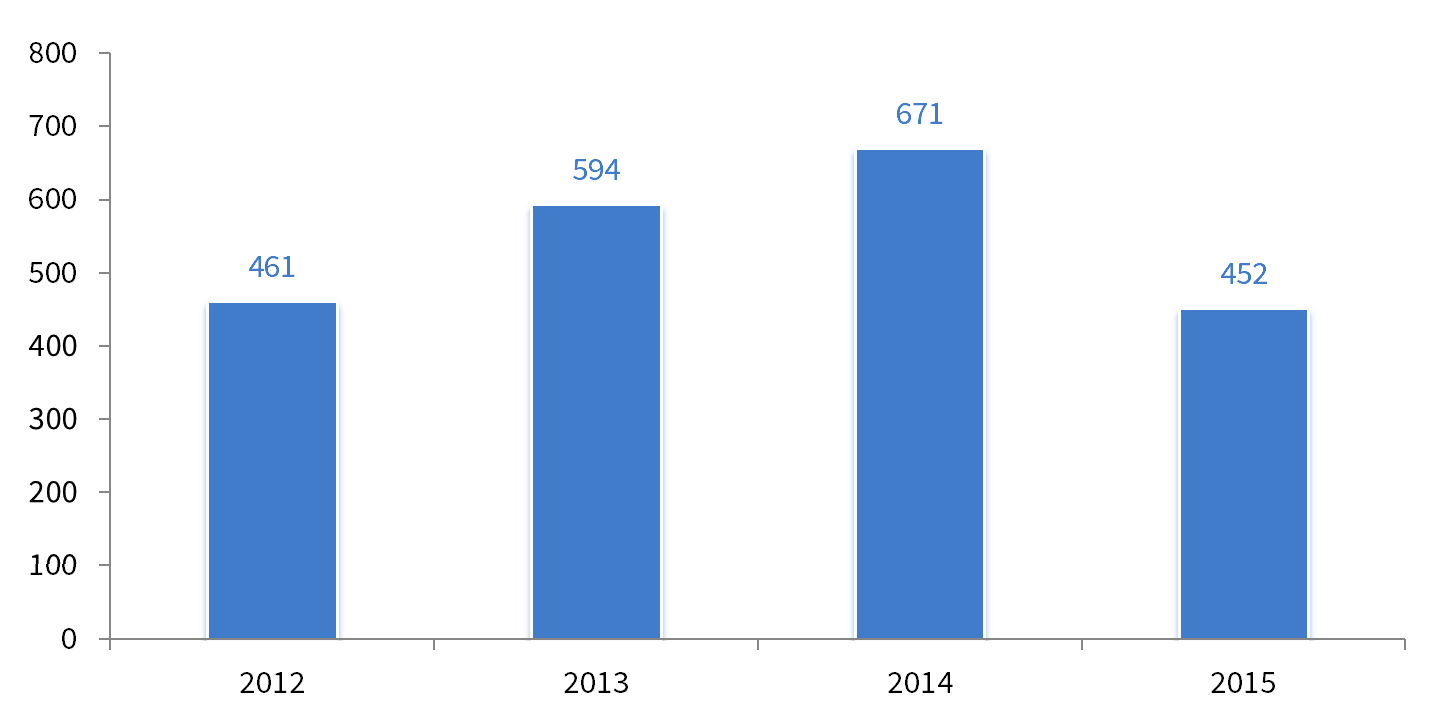
*For 2012 and 2015, data provided for only part of the year.
Source: Data obtained through FOIA by the American Immigration Council.
The allegations contained within the complaints encompass many forms of abuse. According to the data provided by CBP, “Physical abuse” was the most prevalent reason for a complaint, occurring in 59.4 percent of all cases (1,293 instances), followed by “Abuse (other)” (e.g. mentions of “unprofessional behavior,” “rudeness,” or “mistreatment”) in 9.8 percent of the cases. “General misconduct – rude or discourteous conduct” accounted for 5.6 percent of cases; while “Other non-criminal” (primarily instances of verbal abuse, intimidation, and threats) represented a little over 4 percent of complaints; and “Calculated use of force” comprised 3.3 percent (Appendix 3).
The list below provides some outrageous examples of the types of mistreatment highlighted in complaints in which no action was taken or none was reported (Table 1).
|
0601 “Detainee/Alien – Abuse (Physical Abuse)” |
Outcome |
|---|---|
|
A UDA [“Undocumented Alien”] alleges a Border Patrol agent ran him over with an All-Terrain Vehicle (ATV), then parked the ATV on top of him (Sasabe, AZ) |
“No Action.” |
|
Border Patrol agent allegedly placed Taser in the mouth of a U.S. citizen, resulting in injury (Tombstone, AZ) |
No action reported. |
|
Border Patrol agent allegedly struck a UDA [“Undocumented Alien”] on the back of head with shotgun (Laredo, TX) |
“No Action.” |
|
Border Patrol agent allegedly beat, kicked, and made a UDA [“Undocumented Alien”] (a citizen of Ecuador) eat dirt while he was apprehended (Imperial Beach, CA) |
“Open.” |
|
Border Patrol agent allegedly forced a UDA [“Undocumented Alien”] to slide his hands over barbed wire during apprehension (La Grulla, TX) |
“No Action.” |
|
U.S. citizen (pregnant) alleges she was kicked, taken to the ground, and kneed on her back by a Border Patrol agent during apprehension (Armstrong, TX) |
“No Action.” |
|
0606 “Detainee/Alien – Abuse (Other)” |
Outcome |
|---|---|
|
Border Patrol agent allegedly insisted a UAC [“Unaccompanied Alien Child”] sign documents that he did not explain to her (Fort Brown, TX) |
“No Action.” |
|
Border Patrol agent allegedly pulled his weapon and placed it to the head of a UDA (“Undocumented Alien”) and threatened to kill him (Eagle Pass, TX) |
No action reported. |
|
Border Patrol agent allegedly verbally abused and threatened a UAC [“Unaccompanied Alien Child”] with rape and either a weapon or [self-defense] spray (Laredo, TX) |
“No Action.” |
|
Border Patrol agent did not provide food, milk, diapers and medical care to detained mothers, children and UACs [“Unaccompanied Alien Children”] (Laredo, TX) |
“Open.” |
|
“Alien” alleged Border Patrol Agents threatened to beat him up after he claimed fear of returning to El Salvador (Brownsville, TX) |
“No Action.” |
|
1616 “Detainee/Alien – Other Non-criminal” |
Outcome |
|---|---|
|
“Alien” alleged he was kicked in the face by a Border Patrol agent (Falfurrias, TX) |
“No Action.” |
|
Border Patrol agent allegedly ignored UDA’s [“Undocumented Alien’s”] credible fear claims and coerced him to sign English-language papers (San Antonio, TX) |
“No Action.” |
|
Border Patrol agent allegedly put a gun to a UAC’s [“Unaccompanied Alien Child’s”] neck and threatened to kick and kill him (Weslaco, TX) |
“No Action.” |
|
0609 “Detainee/Alien – Physical Assault (Staff on Detainee)” |
Outcome |
|---|---|
|
A UDA [“Undocumented Alien”] alleges Border Patrol agent struck him with shotgun while another Border Patrol agent kicked him in the ribs (Carrizo Springs, TX) |
No action reported. |
|
Border Patrol agent allegedly struck UDA [“Undocumented Alien”] on the head with a rifle stock four times (Sasabe, AZ) |
“No Action.” |
|
A UDA [“Undocumented Alien”] alleges a Border Patrol agent struck him several times while he was stuck in a barbwire fence (San Ysidro, CA) |
“No Action.” |
|
0605 “Detainee/Alien – Abuse (Medical Issue)” |
Outcome |
|---|---|
|
“Alien” in Border Patrol custody was reportedly neglected and suffered a miscarriage (McAllen, TX) |
“No Action.” |
|
Border Patrol agent allegedly denied a UAC [“Unaccompanied Alien Child”] pain medication during his five-day detention (McAllen, TX) |
“No Action.” |
|
Border Patrol agents allegedly ignored and chastised a UDA [“Undocumented Alien”] mother requesting medical attention for her children, who were later diagnosed with bronchitis (McAllen, TX) |
No action reported. |
|
0603 “Detainee/Alien – Abuse (Sexual Abuse)” |
Outcome |
|---|---|
|
A Border Patrol agent allegedly made a minor take off her pants then looked down her underwear (Brownsville, TX) |
“No Action.” |
|
Border Patrol agent allegedly sexually assaulted a female Mexican national while she was in the hospital (Corpus Christi, TX) |
No action reported. |
|
A UDA [“Undocumented Alien”] alleges she was raped by two male Border Patrol agents prior to her apprehension by a female Border Patrol agent (Casa Grande, AZ) |
No action reported. |
|
Supervisory Border Patrol agent allegedly solicited/obtained sexual favors from “illegal alien” in exchange for entrance into the U.S. (Indio, CA) |
No action reported. |
Among the 468 cases in which the victim’s gender was known, nearly 70 percent were male and 30 percent female. Nearly 96.6 percent of the alleged perpetrators of abuse (2,104 cases) were U.S. Border Patrol agents, and 3.4 percent were Border Patrol supervisors.
The number of filed complaints varied substantially between U.S. Border Patrol sectors. More complaints, or 42.5 percent, were filed against agents in the Rio Grande Valley Sector in Texas, followed by the Tucson Sector in Arizona (21.1 percent), the Laredo Sector in Texas (10.7 percent), and the San Diego Sector in California (6.2 percent).
Collectively, these three sectors account for 80.5 percent of all complaints filed between January 2012 and October 2015 (Figure 2).
Figure 2: Number of Complaints Filed Against CBP by Border Patrol Sector,
January 2012 – October 2015
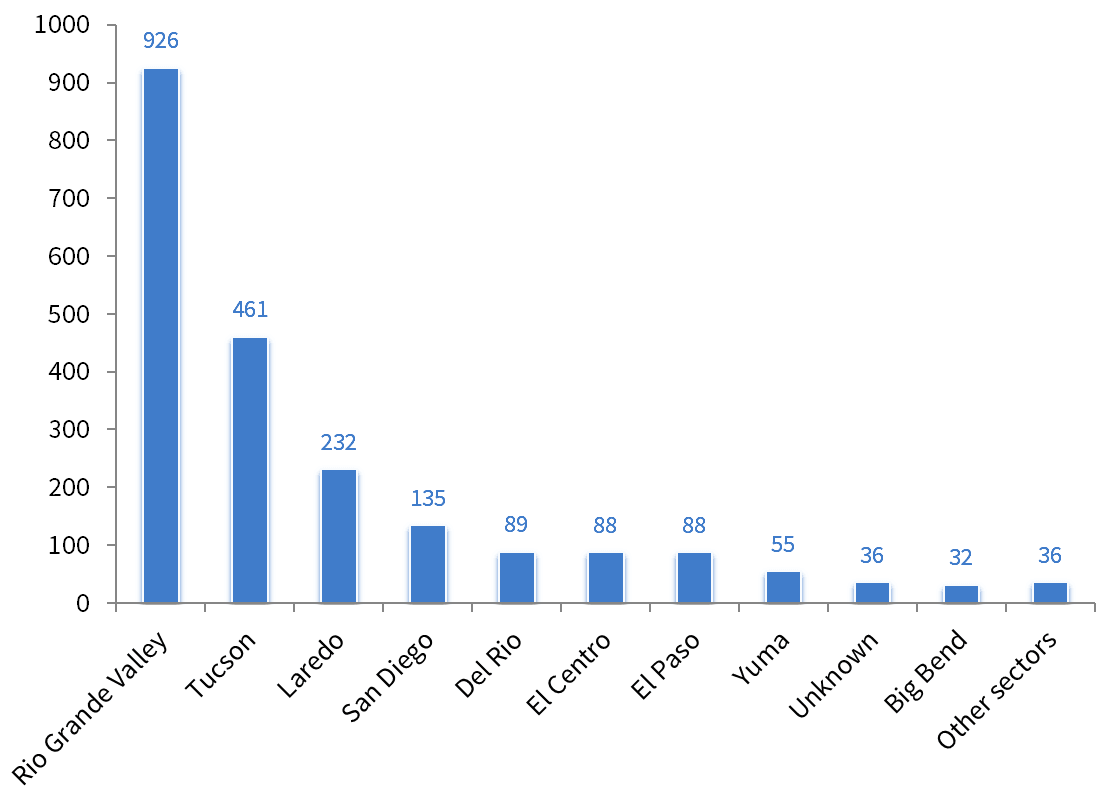
*For 2012 and 2015, data provided for only part of the year.
Source: Data obtained through FOIA by the American Immigration Council.
When accounting for differences in migration flows across Border Patrol sectors, however, the complaint data shows a different pattern. Comparing “complaint rates,” rather than the absolute numbers of complaints, among sectors provides a more accurate picture of the state of affairs along the southwestern border. Using this analysis, the highest rates of complaints filed between January 2012 and October 2015 were in the Yuma Sector in Arizona (218.7 complaints per 100,000 apprehensions), the Big Bend Sector in Texas (192.5), the El Paso Sector in Texas (185.4), the Rio Grande Valley Sector in Texas (141.4), and the El Centro Sector in California (138.1).
Despite the variation, all the southwestern border patrol sectors registered complaint rates of at least 100 complaints per 100,000 apprehensions during the period analyzed (Figure 3).
Figure 3: Number of Complaints Filed Against CBP per 100,000 Apprehensions,
January 2012 – October 2015
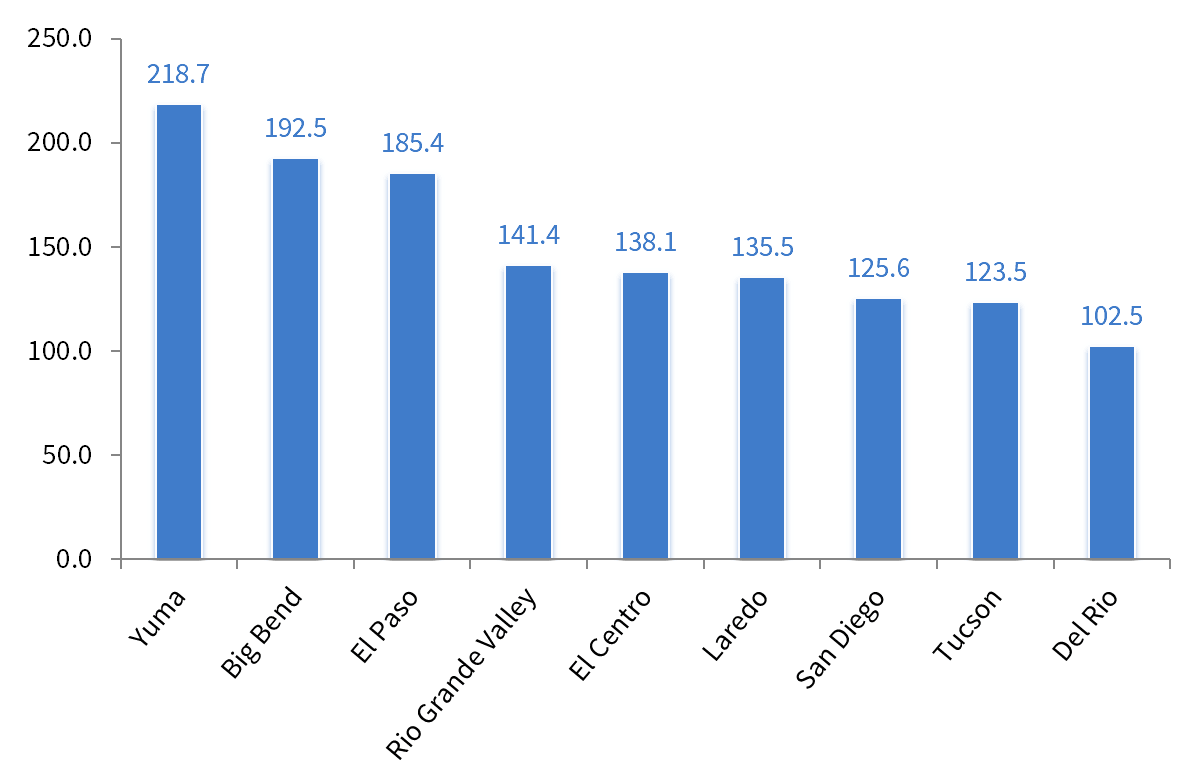
Source: Data obtained through FOIA by the American Immigration Council; U.S. Border Patrol’s Number of Apprehensions by Fiscal Year.
A slightly different distribution emerges when complaint rates are calculated based on the number of Border Patrol agents in each sector. By this measure, the highest complaint rates were in the Rio Grande Valley Sector (315.2 complaints per 1,000 agents), Laredo Sector (130), and Tucson Sector (112.8). Comparatively, the El Paso Sector (34.4), Big Bend Sector (52.2), and San Diego Sector (53.1) had the lowest complaint rates (Figure 4 and Appendix 3).
Figure 4: Number of Complaints Against CBP Filed per 1,000 Border Patrol Agents, 2012-2015*
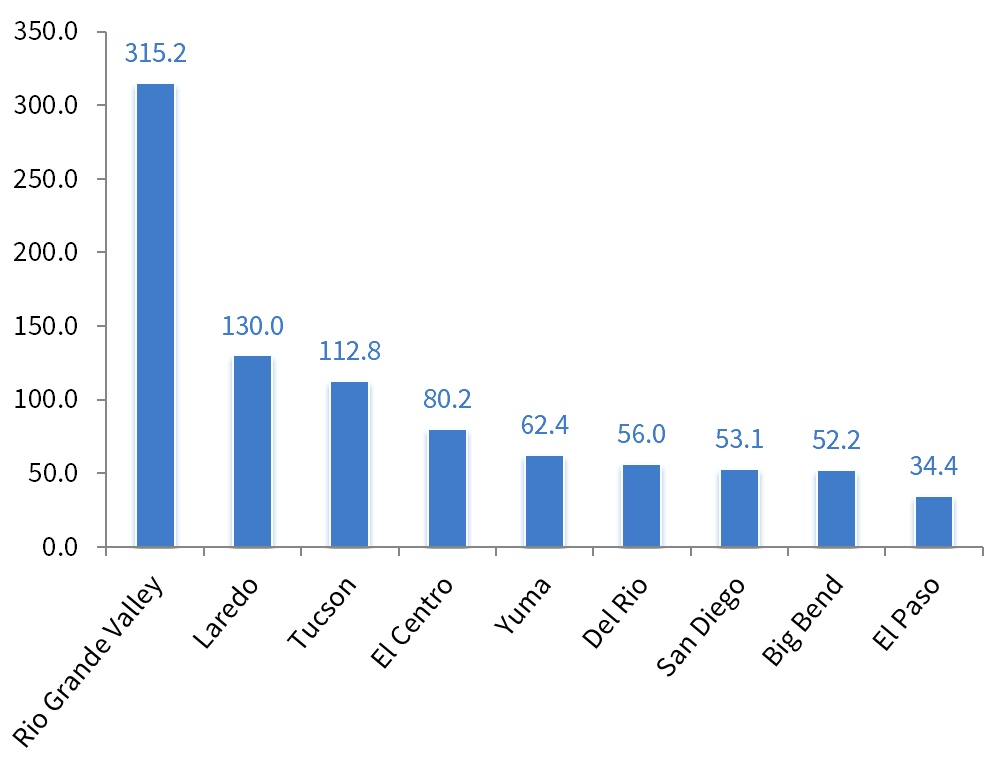
*Complaint rates are calculated using average annual number of agents, FYs 2012-2015.
Source: Data obtained through FOIA by the American Immigration Council; CBP Border Patrol Agent Staffing by Fiscal Year.
Of the 10 stations with the highest number of complaints, seven are in the Rio Grande Valley Sector, three are in the Tucson Sector, and one is in the Laredo Sector (Figure 5).
Among the 2,178 formal complaints filed against the Border Patrol, 55.2 percent (1,203) resulted in “No Action,” while 42.4 percent of complaints (923) were presumably still being investigated when the American Immigration Council received the data in response to the FOIA request.
The remaining 52 cases were identified as having reached resolution. Specifically, 25 complaints resulted in some type of “counseling,” 11 led to some form of reprimand, another 11 resulted in “suspension,” two led to an “alternative remedy,” two received some “other decision,” and one resulted in “resignation” (Figure 6). In other words, among the 1,255 complaints in which a formal decision was made, “No Action” represented nearly 96 percent of all outcomes.
Figure 6: Number of Complaints Filed Against CBP by Decision/Action, 2012-2015
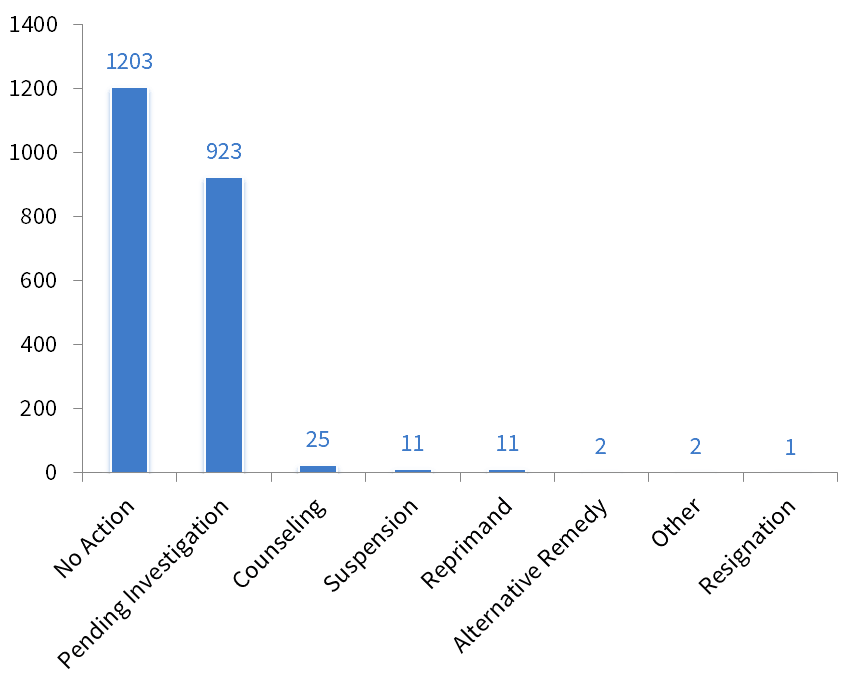
Source: Data obtained through FOIA by the American Immigration Council.
The data examined in this report reveal the remarkable fact that 96 percent of cases in which a Border Patrol agent was alleged to have engaged in misconduct resulted in no action taken against the accused. While the data provided by CBP does not offer sufficient detail to determine whether or not the complaints had merit, the fact that so many seemingly serious allegations resulted in no action is a cause for concern.
It is not surprising that the Rio Grande Valley and Tucson sectors registered more than half of all complaints given that these are the sectors with the highest number of apprehensions. But the same pattern was not apparent when considering complaint rates. When complaints per 100,000 apprehensions were calculated per sector, the highest rates were in the Yuma, Big Bend, and El Paso sectors. And when complaints per number of Border Patrol agents per sector were calculated, the highest rates were in the Rio Grande Valley, Laredo, and Tucson Sector. CBP should closely monitor those sectors to determine why the complaint rates are significantly higher compared to other sectors.
Another remarkable—and problematic—finding of this analysis is that three-fifths of complaints involved allegations of physical abuse. One explanation for this high occurrence could be that people who are physically or visibly abused are more incentivized to file complaints than people who suffer other forms of abuse. Nevertheless, the very fact that the overwhelming majority of complaints centered on alleged physical abuse should be concerning to CBP. Moreover, CBP officials should be troubled by the fact that so little progress has been made over the past three years to better hold Border Patrol agents accountable for alleged abuse.
Appendix 1
Complete list of categories in the original spreadsheet received (excluding duplicates).
Complaints Regarding Border Patrol Misconduct by Type of Allegation
|
Primary Field Description Code |
Frequency |
Percent (%) |
|---|---|---|
|
1610 General Misconduct-Other Non-criminal |
2186 |
8.9 |
|
0801 Conflict of Interest-Association with Known Criminals/Illegal Aliens |
1608 |
6.5 |
|
0601 Detainee/Alien – Abuse (Physical Abuse) |
1453 |
5.9 |
|
1308 Lost/Stolen/Missing-Other Duty Equipment |
1054 |
4.3 |
|
0802 Conflict of Interest-Misuse of Position |
893 |
3.6 |
|
0803 Conflict of Interest-Failure to perform Official Duties |
833 |
3.4 |
|
0712 Other Criminal |
829 |
3.4 |
|
1303 Lost/Missing/Stolen-Badge |
665 |
2.7 |
|
1802 Incidents-General |
644 |
2.6 |
|
1607 General Misconduct-Rude or Discourteous Conduct |
491 |
2.0 |
|
1613 General Misconduct-Government Owned Vehicle Accident |
444 |
1.8 |
|
0202 Smuggling-Aliens |
442 |
1.8 |
|
0201 Smuggling-Drugs |
409 |
1.7 |
|
1106 Harassment – Hostile Work Environment |
407 |
1.6 |
|
1602 General Misconduct-Misuse of TECS (Non-criminal) |
406 |
1.6 |
|
1609 General Misconduct-Arrest of Family Member(nexus to agency mission) |
371 |
1.5 |
|
1206 Falsification-Other |
370 |
1.5 |
|
0705 DUI/DWI |
366 |
1.5 |
|
1801 Incidents-Critical/Significant |
348 |
1.4 |
|
0706 Domestic Violence |
335 |
1.4 |
|
1102 Harassment-Discriminatory |
315 |
1.3 |
|
1605 General Misconduct-Misuse of Government Computer/Email/Mail/Telephone |
270 |
1.1 |
|
0606 Detainee/Alien – Abuse (Other) |
260 |
1.1 |
|
0301 Bribery-Bribery |
242 |
1.0 |
|
1615 General Misconduct-Failure to Pay Government Credit Card/Just Debt |
242 |
1.0 |
|
0902 Disclosure-Law Enforcement Sensitive Information |
241 |
1.0 |
|
1202 Falsification Time & Attendance Related |
227 |
.9 |
|
1103 Harassment-Retaliation |
215 |
.9 |
|
1307 Lost/Missing/Stolen- Credentials |
214 |
.9 |
|
1606 General Misconduct-Conduct unbecoming an Officer |
210 |
.9 |
|
0704 Misuse of TECS (Criminal) |
187 |
.8 |
|
1603 General Misconduct- Misuse/Unauthorized Use of Government Vehicle |
181 |
.7 |
|
1101 Harassment-Sexual |
147 |
.6 |
|
1611 Detainee/Alien – Escape |
140 |
.6 |
|
0404 Intentional Discharge of Service Weapon(No injury/Damage) |
138 |
.6 |
|
1503 Detainee/Alien – Lost/Missing Property/Money |
134 |
.5 |
|
1616 Detainee/Alien – Other Non- criminal |
116 |
.5 |
|
1301 Lost/Missing/Stolen-stolen Service Weapon |
99 |
.4 |
|
1612 General Misconduct- Lost/Missing Property/Money |
99 |
.4 |
|
1001 Employee Substance Abuse- Illegal Substance Abuse |
92 |
.4 |
|
0614 Detainee/Alien – Calculated Use of Force |
90 |
.4 |
|
1201 Falsification-Investigation Related |
89 |
.4 |
|
0904 Disclosure-(General) |
86 |
.3 |
|
1104 Harassment-Workplace Violence |
75 |
.3 |
|
0408 Unintentional Discharge of Service Weapon (No Injury/Damage) |
74 |
.3 |
|
0407 Unintentional Discharge of Service Weapon (Property Damage) |
71 |
.3 |
|
0506 CRCL-Detainee/Alien (Other) |
70 |
.3 |
|
0711 Restraining Orders |
69 |
.3 |
|
0506 CRCL-Detainee/Alien (Other) |
67 |
.3 |
|
1604 General Misconduct- Misuse/Unauthorized Use of Government Credit Card |
67 |
.3 |
|
0609 Detainee/Alien – Physical Assault (Staff on Detainee) |
62 |
.3 |
|
0709 Other Alcohol related Arrests |
60 |
.2 |
|
1203 Falsification-Employment Related |
55 |
.2 |
|
1601 General Misconduct- Inappropriate Supervisor/Subordinate Relationship |
54 |
.2 |
|
0710 Stalking/Harassment |
53 |
.2 |
|
1204 Falsification-Worker’s Comp Related |
53 |
.2 |
|
0718 Threat |
52 |
.2 |
|
0701 Theft of Detainee/Alien/Civilian (Money) |
51 |
.2 |
|
Non-Criminal Misconduct |
49 |
.2 |
|
1302 Lost/Missing/Stolen-Lost Service Weapon |
48 |
.2 |
|
0401 Intentional Discharge of Service Weapon(Death/Serious Injury) |
46 |
.2 |
|
1105 Harassment-Profiling |
44 |
.2 |
|
1401 Mismanagement-Gross Financial |
44 |
.2 |
|
1402 Mismanagement-Personnel |
44 |
.2 |
|
0203 Smuggling-Other |
43 |
.2 |
|
0501 CRCL-Detainee/Alien Physical Abuse |
41 |
.2 |
|
1614 Lack of Candor |
41 |
.2 |
|
0707 Disorderly Conduct |
33 |
.1 |
|
1617 Inappropriate storage of government is sued property |
29 |
.1 |
|
0702 Theft of Detainee/Alien/Civilian (Property) |
28 |
.1 |
|
1702 Seizure Discrepancies-Money |
25 |
.1 |
|
1701 Seizure Discrepancies- Drugs |
24 |
.1 |
|
0603 Detainee/Alien – Abuse (Sexual Abuse) |
23 |
.1 |
|
0605 Detainee/Alien – Abuse (Medical Issue) |
22 |
.1 |
|
0901 Disclosure-Classified Information |
21 |
.1 |
|
0903 Disclosure-Personally Identifiable Information (PII) |
21 |
.1 |
|
0403 Intentional Discharge of Service Weapon (Property Damage) |
20 |
.1 |
|
1205 Falsification- Travel/Relocation |
20 |
.1 |
|
0613 Detainee/Alien – Medical Issue |
18 |
.1 |
|
0612 Detainee/Alien – Sexual Assault (Staff on Detainee) |
16 |
.1 |
|
1704 Seizure Discrepancies-Other |
15 |
.1 |
|
1608 General Misconduct-AWOL |
14 |
.1 |
|
0402 Intentional Discharge of Service Weapon (Minor Injury) |
13 |
.1 |
|
0632 Detainee – Funds and Personal Property |
13 |
.1 |
|
0406 Unintentional Discharge of Service Weapon (Minor Injury) |
11 |
.0 |
|
Unintentional/inadvertent Disclosure |
11 |
.0 |
|
0103 Death-Employee (Off duty, i.e. Suicide w/ Duty Weapon) |
10 |
.0 |
|
0660 Detainee – Use of Force and Restraints |
10 |
.0 |
|
0804 Conflict of Interest- Government Contract related |
9 |
.0 |
|
0104 Death-Employee (Off duty Suicide) |
8 |
.0 |
|
0647 Detainee – Searches of Detainees |
8 |
.0 |
|
Detainee/Alien/Civilian (Result of Agency Action) |
8 |
.0 |
|
0101 Death-Employee On Duty |
7 |
.0 |
|
0110 Death-Employee (Off Duty) |
7 |
.0 |
|
0600 Detainee/Alien – Sexual Harassment (Staff-on-Detainee) |
7 |
.0 |
|
0708 Bad Checks |
7 |
.0 |
|
0503 CRCL-Detainee/Alien – Abuse (Sexual Abuse) |
6 |
.0 |
|
0505 CRCL-Detainee/Alien (Medical issue) |
6 |
.0 |
|
0713 Impersonation |
6 |
.0 |
|
1304 Lost/Missing/Stolen- Computer/Thumbdrive (w/Sensitive Information) |
6 |
.0 |
|
1305 Lost/Missing/Stolen- Computer/Thumbdrive |
6 |
.0 |
|
0608 Detainee/Alien – Physical Assault (Detainee on Staff) |
5 |
.0 |
|
0631 Detainee – Food Service |
5 |
.0 |
|
0105 Death-Relative of Employee (i.e., Suicide w/ Duty Weapon) |
4 |
.0 |
|
0106 Death-Employee (Off duty, no nexus to agency) |
4 |
.0 |
|
0108 Death-Detainee/Alien (Unknown Cause) |
4 |
.0 |
|
0302 Bribery-Good Guy Bribe |
4 |
.0 |
|
0628 Detainee – Environmental Health and Safety |
4 |
.0 |
|
0634 Detainee – Hold Rooms in Detention Facilities |
4 |
.0 |
|
0640 Detainee – Medical Care |
4 |
.0 |
|
1003 Employee Substance Abuse- Self Reported Illegal Substance Abuse |
4 |
.0 |
|
1306 Lost/Missing/Stolen-Sensor Maps |
4 |
.0 |
|
0620 Detainee – Admission and Release |
3 |
.0 |
|
0652 Detainee – Staff-Detainee Communications |
3 |
.0 |
|
0655 Detainee – Telephone Access |
3 |
.0 |
|
0102 Death- Detainee/Alien/Civilian (Result of Agency Action) |
2 |
.0 |
|
0615 Detainee/Alien – Suicide Attempt |
2 |
.0 |
|
1901 Privacy Act |
2 |
.0 |
|
0100 Death-Employee (On duty Suicide) |
1 |
.0 |
|
0610 Detainee/Alien – Sexual Assault (Detainee on Detainee) |
1 |
.0 |
|
0619 Detainee/Alien – Death (Unknown Cause) |
1 |
.0 |
|
0663 Detainee – Assault-Staff on Detainee |
1 |
.0 |
|
Description missing |
4218 |
17.1 |
|
Total |
24692 |
100.0 |
Appendix 2
Full list of categories of complaints selected for this analysis.
Complaints Regarding Border Patrol Misconduct by Type of Allegation
|
Primary Field Description Code |
Frequency |
Percent (%) |
|---|---|---|
|
0601 Detainee/Alien – Abuse (Physical Abuse) |
1,293 |
59.4 |
|
0606 Detainee/Alien – Abuse (Other) |
214 |
9.8 |
|
1607 General Misconduct-Rude or Discourteous Conduct |
121 |
5.6 |
|
1616 Detainee/Alien – Other Non- criminal |
93 |
4.3 |
|
0614 Detainee/Alien – Calculated Use of Force |
72 |
3.3 |
|
0609 Detainee/Alien – Physical Assault (Staff on Detainee) |
54 |
2.5 |
|
0506 CRCL-Detainee/Alien (Other) |
43 |
2.0 |
|
0401 Intentional Discharge of Service Weapon(Death/Serious Injury) |
41 |
1.9 |
|
1612 General Misconduct- Lost/Missing Property/Money |
36 |
1.7 |
|
0501 CRCL-Detainee/Alien Physical Abuse |
28 |
1.3 |
|
0701 Theft of Detainee/Alien/Civilian (Money) |
27 |
1.2 |
|
0605 Detainee/Alien – Abuse (Medical Issue) |
21 |
1.0 |
|
0613 Detainee/Alien – Medical Issue |
17 |
.8 |
|
0603 Detainee/Alien – Abuse (Sexual Abuse) |
16 |
.7 |
|
0402 Intentional Discharge of Service Weapon (Minor Injury) |
13 |
.6 |
|
0702 Theft of Detainee/Alien/Civilian (Property) |
12 |
.6 |
|
0612 Detainee/Alien – Sexual Assault (Staff on Detainee) |
11 |
.5 |
|
1105 Harassment-Profiling |
11 |
.5 |
|
0660 Detainee – Use of Force and Restraints |
8 |
.4 |
|
0600 Detainee/Alien – Sexual Harassment (Staff-on-Detainee) |
6 |
.3 |
|
0631 Detainee – Food Service |
5 |
.2 |
|
0108 Death-Detainee/Alien (Unknown Cause) |
4 |
.2 |
|
0505 CRCL-Detainee/Alien (Medical issue) |
4 |
.2 |
|
0628 Detainee – Environmental Health and Safety |
4 |
.2 |
|
0634 Detainee – Hold Rooms in Detention Facilities |
4 |
.2 |
|
0640 Detainee – Medical Care |
4 |
.2 |
|
0620 Detainee – Admission and Release |
3 |
.1 |
|
0652 Detainee – Staff-Detainee Communications |
3 |
.1 |
|
0102 Death- Detainee/Alien/Civilian (Result of Agency Action) |
2 |
.1 |
|
0503 CRCL-Detainee/Alien – Abuse (Sexual Abuse) |
2 |
.1 |
|
0608 Detainee/Alien – Physical Assault (Detainee on Staff) |
2 |
.1 |
|
0647 Detainee – Searches of Detainees |
2 |
.1 |
|
0610 Detainee/Alien – Sexual Assault (Detainee on Detainee) |
1 |
.0 |
|
0663 Detainee – Assault-Staff on Detainee |
1 |
.0 |
|
Total |
2,178 |
100.0 |
Appendix 3
Complaints, Apprehensions, and Agents by Southwest Border Sectors
|
Sector |
Complaints Jan. 2012 – Oct. 2015 |
Apprehensions Jan. 2012 – Oct 2015 |
Agents (average, FY 2012 – 2015) |
Complaints per 100,000 apprehensions |
Complaints per 1,000 agents* |
|---|---|---|---|---|---|
|
Rio Grande Valley |
926 |
654,902 |
2,938 |
141.4 |
315.2 |
|
Tucson |
461 |
373,383 |
4,089 |
123.5 |
112.8 |
|
Laredo |
232 |
171,170 |
1,785 |
135.5 |
130.0 |
|
San Diego |
135 |
107,479 |
2,543 |
125.6 |
53.1 |
|
Del Rio |
89 |
86,847 |
1588 |
102.5 |
56.0 |
|
El Centro |
88 |
63,722
|
1097 |
138.1 |
80.2 |
|
El Paso |
88 |
47,462 |
2559 |
185.4 |
34.4 |
|
Yuma |
55 |
25,149
|
882 |
218.7 |
62.4 |
|
Big Bend |
32 |
16,621 |
613 |
192.5 |
52.2 |
*Complaint rates are calculated using average annual number of agents, FYs 2012-2015.
